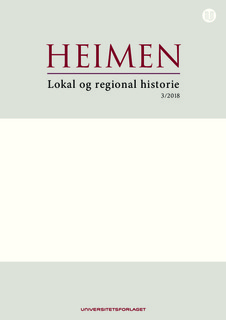| dc.contributor.author | Kolberg, Are Skarstein | |
| dc.date.accessioned | 2019-03-28T11:36:41Z | |
| dc.date.available | 2019-03-28T11:36:41Z | |
| dc.date.created | 2018-11-25T21:57:06Z | |
| dc.date.issued | 2018 | |
| dc.identifier.citation | Heimen - Lokal og regional historie. 2018, 55 (3), 211-231. | nb_NO |
| dc.identifier.issn | 0017-9841 | |
| dc.identifier.uri | http://hdl.handle.net/11250/2592182 | |
| dc.description.abstract | The article deals with the outskirts of European great power conflicts aiming to analyse how continental conflicts and wars affected settlements beyond their epicentres, on the fringes of Europe as it were. One aim is to analyse to which extent civilian populations on the outskirts experienced these conflicts but also to which extent communities were shaped by them, directly as well as indirectly. The main conflict of study is the Thirty Years’ war as this was the period in which the fortress of Skånes, the case study presented in the article, was first commissioned. The fortress of Skånes in Levanger will be used as a backdrop against which these conflicts will be studied. The actual confines of the fortress throughout its different phases, from its construction in 1643 up to its decommissioning and subsequent demolition in 1747, will be used in an attempt to measure the overall impact on society. The idea is that the size of the fortress mirrors the gravity of the situation and the perceived threat. There are written sources in the form of archives and tax registers which can give good indications of the overall situation but as for more specific events, data is sometimes scarce. There is however, ample military cartographic material. These maps will be used in an interdisciplinary analysis together with archaeology and the written sources to try to glean a clearer picture of the different phases that will be dealt with in this paper. By archaeology is first and foremost meant the visible remains in today’s landscape, as finds remain few, or they are simply not turned in and recorded, as the Norwegian heritage legislation does not cover stray finds from after the Reformation. By visible remains is meant earthworks and traces of bastions; the barrel-vaulted cellar of the powder magazine still remains under a present-day farm house. | nb_NO |
| dc.language.iso | nob | nb_NO |
| dc.publisher | Universitetsforlaget | nb_NO |
| dc.rights | Navngivelse-Ikkekommersiell 4.0 Internasjonal | * |
| dc.rights.uri | http://creativecommons.org/licenses/by-nc/4.0/deed.no | * |
| dc.title | I utkanten av konfliktene - En tverrfaglig studie av 1600–1700-tallets kriger og konflikter på kontinentet og deres innvirkning på en liten gård med lokalsamfunn innerst i Trondheimsfjorden | nb_NO |
| dc.type | Journal article | nb_NO |
| dc.type | Peer reviewed | nb_NO |
| dc.description.version | publishedVersion | nb_NO |
| dc.source.pagenumber | 211-231 | nb_NO |
| dc.source.volume | 55 | nb_NO |
| dc.source.journal | Heimen - Lokal og regional historie | nb_NO |
| dc.source.issue | 3 | nb_NO |
| dc.identifier.doi | 10.18261/issn.1894-3195-2018-03-02 | |
| dc.identifier.cristin | 1634757 | |
| dc.description.localcode | This article is downloaded from www.idunn.no. © 2018 Author(s). This is an open access article distributed under the terms of the Creative Commons CC-BY-NC 4.0 License (http://creativecommons.org/licenses/by-nc/4.0/). | nb_NO |
| cristin.unitcode | 194,31,5,0 | |
| cristin.unitname | Institutt for arkeologi og kulturhistorie | |
| cristin.ispublished | true | |
| cristin.fulltext | original | |
| cristin.qualitycode | 1 | |

